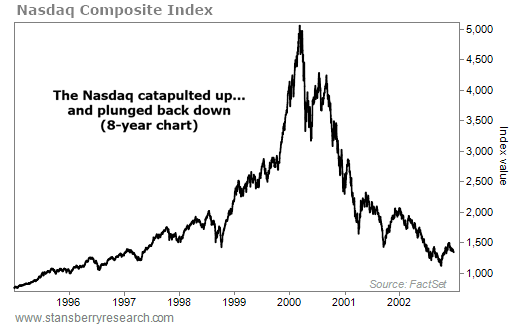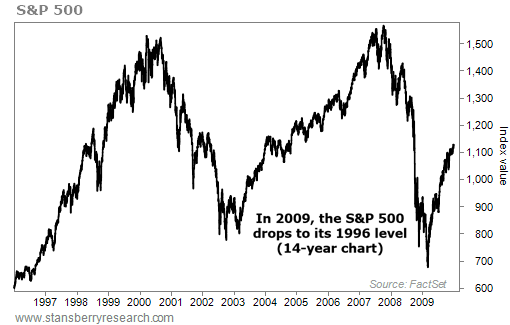Doc's note: Almost every day, readers ask me if we're in a bubble. They want to know if there's still time to invest in stocks or if it's safer to stay out of the market.
Today, Extreme Value editor Dan Ferris shows you exactly what a bubble looks like and why he thinks we're headed for a crash landing...
Every market bubble is a time machine...
On the way up, it catapults you into the future... with asset prices rising on the highest of hopes.
Then, it wrenches you back into the past on the way down... as hopes go unrealized and investors flee risky assets in a panic.
To help you see what I mean let's run through a couple of history's time machine journeys. I want to make sure you know what a bubble feels like.
We'll also get into what we're seeing in the stock market right now. And as I believe you'll see, the time machine is stuck careening into the future... headed for a crash landing.
We'll start with the example of the dot-com bubble...
The Nasdaq Composite Index peaked at 5,048 on March 10, 2000. That moment provided a glimpse into the future – as the index wouldn't see that level again for 15 years.
Then, the time machine shifted into reverse at top speed... The dot-com bust took the Nasdaq down 78% to as low as 1,114 on October 9, 2002 – a level it hadn't seen since 1996.
Within a span of just 31 months, the Nasdaq time machine shifted from gazing 15 years into the future to six years in the past. Take a look at this incredible round trip...

The stock market places a value on the businesses that trade within it. By buying and selling stocks, investors assign a value on companies' future earnings every day.
And with this round trip, it was almost as if the world didn't believe in the promise of the Internet bubble...
You see, in the 1990s, most of the new Internet companies traded on the Nasdaq. And the index rose more than 570% from the start of 1995 through its March 2000 peak – effectively discounting decades' worth of massive earnings growth. But most of that never materialized... Many early dot-com companies didn't have any revenues, let alone earnings.
So then, starting in March 2000, the market swiftly transported investors back in time...
As I said, the Nasdaq fell 78% over the next two and a half years to its bottom in October 2002. The time machine transported investors back to August 1996... the same year that then-Federal Reserve Chair Alan Greenspan coined the term "irrational exuberance" to describe the growing stock market mania.
It was like that scene in the 1981 action movie, Raiders of the Lost Ark, where Indiana Jones' friend, Dr. Marcus Brody, described the destruction of an ancient city as having been "wiped clean by the wrath of God."
Likewise, the market's wrath wiped the bubble clean out of existence... The Nasdaq didn't eclipse its March 2000 peak until April 2015. The benchmark S&P 500 Index, which isn't as tech-heavy, peaked in April 2000 and took eight years to travel back to a new high.
The Federal Reserve lowered interest rates throughout the dot-com bust. The market bottomed in October 2002... and by the end of that year, 30-year mortgage rates dipped below 6% for the first time in history.
But wait, there's more...
It wouldn't be long before the stock market went on another trip in the time machine...
By 2006, just six years after the last bubble peaked, housing prices had soared. Folks who had soured on technology investments were taking out low-interest mortgages and buying their dream houses.
A full-blown housing and mortgage bubble was raging... The share prices of homebuilders, subprime lenders, banks, furniture stores, home-improvement chains, and anything else connected with the housing industry soared.
Housing stocks and subprime mortgage companies began to weaken in 2007. The S&P 500 peaked in October of that year, and the housing bubble blew up completely in 2008.
This trip in the time machine caused the biggest crisis since the Great Depression. By March 2009, the S&P 500 had fallen 58% – transporting it back 13 years to its 1996 level...

Two bubbles within less than a decade of each other... The time machine can get busy.
And that brings us to today, with the time machine collecting dust and ready to get going again...
With the S&P 500 at new all-time highs, the stock market has its gaze fixed on the future. And it's the brightest future the market has ever contemplated... brighter even than the one it glimpsed in March 2000.
You can tell the market thinks the future is brighter than ever because stocks are more expensive than they've ever been at any time, including the 1929 and 2000 peaks.
Now, I don't like to make predictions...
It's too hard to get them right. And even if you're eventually proven right, the ride is still likely to be very painful...
Economists Robert Shiller and John Campbell predicted zero returns from stocks for a decade starting in 1996. And they were proven approximately right... but they had to watch the market go up 20% annually for four years before their prediction came true.
Not to mention, most business leaders knew the dot-com bubble was ridiculous.
Perhaps the most famous quote to that effect comes from a founder and CEO who knew his company was drastically overvalued at the time. But he had to keep it to himself, for fear of being sued and losing control of his company. Here's what the founder and CEO said...
Two years ago, we were selling at 10 times revenues when we were at $64. At 10 times revenues, to give you a 10-year payback, I have to pay you 100% of revenues for 10 straight years in dividends.
That assumes I can get that by my shareholders. That assumes I have zero cost of goods sold, which is very hard for a computer company. That assumes zero expenses, which is really hard with 39,000 employees. That assumes I pay no taxes, which is very hard. And that assumes you pay no taxes on your dividends, which is kind of illegal. And that assumes with zero R&D for the next 10 years, I can maintain the current revenue run rate.
Now, having done that, would any of you like to buy my stock at $64? Do you realize how ridiculous those basic assumptions are? You don't need any transparency. You don't need any footnotes. What were you thinking?
The quote comes from Scott McNealy, the founder and CEO of dot-com darling Sun Microsystems. He was talking to a Bloomberg reporter in March 2002, two years after the dot-com bubble peaked.
Bloomberg then asked McNealy, "What were you thinking?" He replied...
I was thinking it was at $64, what do I do? I'm here to represent the shareholders. Do I stand up and say, "Sell"? I'd get sued if I said that. Do I stand up and say, "Buy"? Then they say you're [Enron Chairman] Ken Lay.
So you just sit there and go, "I'm going to be a bum for the next two years. I'm just going to keep my mouth shut, and I'm not going to predict anything."
And that's what I did.
McNealy was probably worrying too much.
Last May, Elon Musk – founder and CEO of Tesla – did exactly what McNealy was afraid to do at the top of the dot-com bubble...
And hardly anyone noticed or cared.
Musk posted on Twitter on May 1, 2020, "Tesla stock price is too high [in my opinion]."
The stock was trading at a split-adjusted price of between roughly $150 and $170 per share at the time... And it had showed some weakness for two trading sessions, dipping into the high $130s. Then, after Musk's post, it was off to the races again... hitting $200 by June 10 and $300 a month after that.
Musk told the whole world his company was overvalued. He effectively told the whole world to sell his stock, exactly what McNealy said he could not do for fear of getting sued. Yet Tesla's stock has more than quadrupled since Musk's tweet...
This is what a bubble looks like.
For years, I've shown readers how to generate extraordinary results while raising the alarm about one speculative bubble after another.
As I said, I don't make predictions.
That's why I recently released details of what I call the "holy grail" of stocks...
This stock has 1,000% long-term potential – in a low-risk, low-volatility stock that could soar in a "Melt Up"... and potentially do even better when stocks inevitably break down.
It's maybe once or twice per decade that I see an opportunity anywhere near this good... with the potential for hundreds – if not thousands – of percent upside and limited risk.
And I believe this one beats them all.
Good investing,
Dan Ferris
